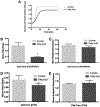In vivo modeling of docosahexaenoic acid and eicosapentaenoic acid-mediated inhibition of both platelet function and accumulation in arterial thrombi
- PMID: 29286871
- PMCID: PMC6146071
- DOI: 10.1080/09537104.2017.1420154
In vivo modeling of docosahexaenoic acid and eicosapentaenoic acid-mediated inhibition of both platelet function and accumulation in arterial thrombi
Abstract
Omega-3 polyunsaturated fatty acids (n-3 PUFAs) are associated with a variety of cellular alterations that mitigate cardiovascular disease. However, pinpointing the positive therapeutic effects is challenging due to inconsistent clinical trial results and overly simplistic in vitro studies. Here we aimed to develop realistic models of n-3 PUFA effects on platelet function so that preclinical results can better align with and predict clinical outcomes. Human platelets incubated with the n-3 PUFAs docosahexaenoic acid and eicosapentaenoic acid were stimulated with agonist combinations mirroring distinct regions of a growing thrombus. Platelet responses were then monitored in a number of ex-vivo functional assays. Furthermore, intravital microscopy was used to monitor arterial thrombosis and fibrin deposition in mice fed an n-3 PUFA-enriched diet. We found that n-3 PUFA treatment had minimal effects on many basic ex-vivo measures of platelet function using agonist combinations. However, n-3 PUFA treatment delayed platelet-derived thrombin generation in both humans and mice. This impaired thrombin production paralleled a reduced platelet accumulation within thrombi formed in either small arterioles or larger arteries of mice fed an n-3 PUFA-enriched diet, without impacting P-selectin exposure. Despite an apparent lack of robust effects in many ex-vivo assays of platelet function, increased exposure to n-3 PUFAs reduces platelet-mediated thrombin generation and attenuates elements of thrombus formation. These data support the cardioprotective value of-3 PUFAs and strongly suggest that they modify elements of platelet function in vivo.
Keywords: Intravital microscopy; omega-3 fatty acids; platelet activation; platelets; thrombosis.
Figures







References
-
- Von Schacky C, Harris WS. Cardiovascular benefits of omega-3 fatty acids. Cardiovasc Res. 2007;73(2):310–315. - PubMed
-
- Breslow JL. n-3 fatty acids and cardiovascular disease. Am J Clin Nutr. 2006;83(6 Suppl):1477S–1482S. - PubMed
-
- Siscovick DS, Raghunathan TE, King I, Weinmann S, Wicklund KG, Albright J, Bovbjerg V, Arbogast P, Smith H, Kushi LH, et al. Dietary intake and cell membrane levels of long-chain n-3 polyun-saturated fatty acids and the risk of primary cardiac arrest. JAMA. 1995;274(17):1363–1367. - PubMed
MeSH terms
Substances
Grants and funding
LinkOut - more resources
Full Text Sources
Other Literature Sources
